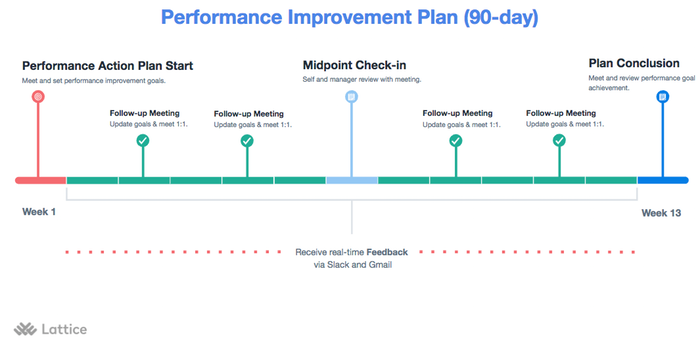Employee feedback is crucial in any workplace. Not only does feedback help boost productivity and improve efficiency, it can help the employee grow and develop their skills overall.
There are several ways to deliver feedback, both informally, through discussions in the moment or praising publicly, and formally, such as through one-on-one meetings and annual performance reviews. Either way, employee feedback should be given as soon as possible because that’s when it’s most relevant, and because it can resolve performance issues in real-time.
Unfortunately, not all employees implement the feedback they receive from their managers. There could be many reasons why: the employee doesn’t have a clear understanding of performance expectations, they didn’t receive proper training or enough resources, they may be going through a personal issue, etc. So as a manager, what can you do to improve an employee’s lackluster work performance?
One way to hold employees accountable is through a performance improvement plan, otherwise known as a performance development plan or a performance success plan. A PIP is a formal document, which outlines performance issues and goals to improve an employee's performance, all to be met within a certain timeframe. The PIP process is usually what follows official documentation of two repeated offenses, in which these offenses are communicated clearly to the employee by a manager.
While they can be an essential part of performance management, PIPs tend to have a bad rap, especially if implemented incorrectly. In particular, they can feel like a punishment when focused on past employee performance rather than development. According to Powerful author and former Netflix Chief Talent Officer Patty McCord, the traditional performance review tends to be driven by a fear of being fired or laid off, since it requires a detailed paper trail of poor performance. Leadership consultant Dr. Flo Falayi advocates doing away with the performance review altogether, while another Forbes contributor, Liz Ryan, stresses that in fear-based organizations, PIPs can send the wrong message to employees: something along the lines of, “I control your livelihood, so don’t cross me.” But if you truly value them, you must communicate clearly and help the employee understand that a formal performance improvement plan is an investment in them, not a death sentence for their job. The PIP is there to help them as an employee succeed; its end result should be your underperforming employee reaching improvement goals the manager believes to be attainable, and growing into a better employee in the process.
Steps for Creating a Performance Improvement Plan
1. An evaluation of their current job performance, as well as performance in the past.
Read up on the employee’s record or personnel file. What is their overall performance history up until now? Have they had similar performance issues in the past, and were they documented? Or are these issues something entirely new? (If the issues are recent, Forbes stresses that it may be especially important to talk to the employee as a first step; a candid conversation might reveal that there’s a simple fix for whatever they’re struggling with.)
2. An explanation of expected performance by a certain date.
Establish a hard deadline. When should the goal be completed by? For Personnel Today, Huw Cooke says the period of time—whether it’s two weeks, two months, or a quarter—depends on the situation. Consider the job description and the nature of the job, your own procedures and practices, the employee’s past performance and personal circumstances, your resources within the workplace, and any agreement with a trade union.
3. A performance action plan, with clear expectations and clear consequences.
Your PIP goals should be established immediately, and should be SMART—Specific, Accurate, Relevant, and Time-bound—so the employee knows exactly how to complete them. According to the Society for Human Resource Management (SHRM), a more specific example of a SMART goal in a PIP is: “During this 90-day performance evaluation, the employee must have perfect attendance, with the exception of approved medical or family absences. They must clock in and be ready for work by the start of each scheduled shift, return from all scheduled breaks on time and remain at work for their entire shift.” Also, be sure to identify any additional disciplinary action if progress isn’t made, such as a three-strike policy.
4. Specific resources, training, and time the employee needs to meet these goals
Will the employee require additional training and educational materials, such as a workbook or new desk supplies, to develop the skills required to complete the goals? Will the employee need to pull resources, such as from the office budget, for the goals? Do these goals individually require a certain time frame, such as how long it would take an employee to read an entire book?
5. Regular meetings with manager regarding PIP progress.
Create a timeline of meetings. There should be multiple meetings over a given time period—for touching base regularly, and a midpoint check-in — to track progress before the goal is expected to be completed. When the plan is presented to the employee, schedule meetings into both of your calendars during this time, so that check-ins are already planned in advance.
Here's a visual representation of a PIP in action. Keep in mind this is just a roadmap that can (and should) be tailored to fit your workplace, employees, and the specific situation surrounding a performance issue.

For instance, if an employee misses a deadline, a goal could be to create smaller deadlines with specific tasks over a long period of time. If an employee misses a monthly deadline, consider creating a timeline of weekly (and perhaps also daily) targets with smaller, mini-tasks to help the employee make progress towards a whole, bigger goal within that monthly deadline.
Examples of inappropriate behavior, where such a plan would be useful:
- An employee skips meetings
- An employee continuously makes disrespectful or offensive comments towards coworkers
- An employee is unprofessional when engaging with customers
- An employee fails to meet deadlines
- An employee violates office safety regulations
- An employee regularly arrives late to their shifts
- An employee repeatedly fails to follow specific instructions
Although PIPs can be a useful tool to address problems, they can definitely be used against an employee. They might seem to be a last step before firing someone -- simply delaying the inevitable. At times, they can even be used for failure. Before a manager crafts a plan for an employee, they should consider whether the employee addressing their problems seems realistic. If the person in question has a long history of ignoring emails, even when the lack of communication has been previously addressed by the manager on multiple occasions, the problem may never be solved. In that scenario, it may be worthwhile to consider letting the employee go, especially if they haven’t made any effort to change their habits.
If you feel an employee can improve their performance issues, a PIP is worth a shot. In the end, it’s not just about what they contribute to your specific workplace, but instead, their ability to be a reliable, responsible employee who can meet performance standards, regardless of workplace.







